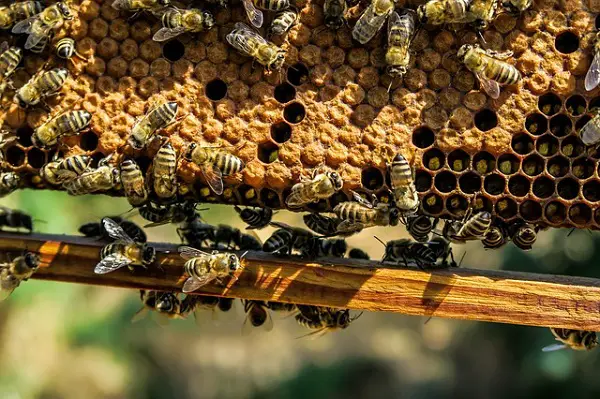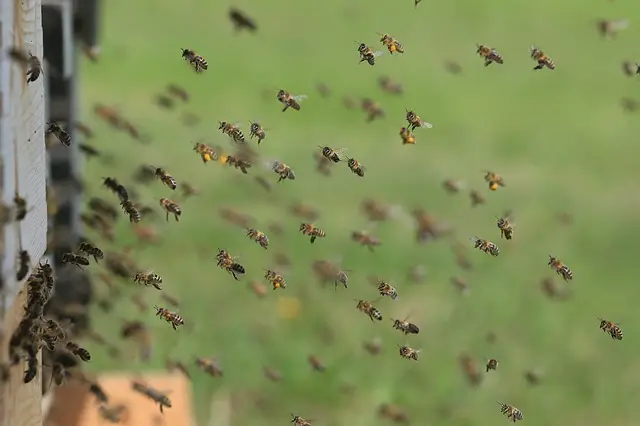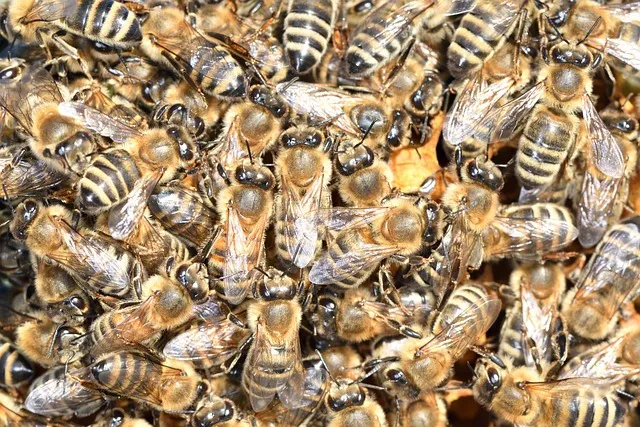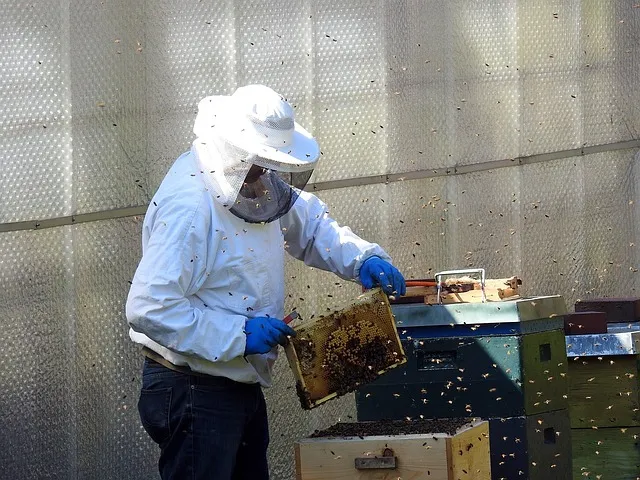How to get rid of Hives? On arm? Should it be removed Overnight?
While honey bees are a vital part of our ecosystem, they can become troublesome if they are around your home or have decided to settle on your property. It makes it even worse if you or a family member is allergic to bee stings since it can lead to instant death.
Bees are one of the most social creatures known. Their presence on your property attracts about 50,000 of them. Knowing how to get rid of them safely before the worst happens is vital. Beekeepers may also be required to destroy their diseased colonies.
Similar Articles you may like to read –
Does vinegar help with bees?
What happens if you crush a bee?
How to Move a Beehive Without Losing Bees?
What time of the day is best to move a hive?
How to Get Rid of Hives?
An established bee colony can reside in a cavity or wall on your property for years. They may produce swarms each year that may also find a resident in your home. Such colonies can either be killed or removed. If in a cavity or inside a wall, the structure must be opened to expose the nest and remove the bees and combs. The building should then be reconstructed and the cavity sealed. The combs and hive debris should be thoroughly removed to prevent future swarms. The residue can attract ants, moths, beetles, or even rodents. Odors of fermenting honey and dead bees can also diffuse your house.
How to Remove Hives Without Hurting the Bees
In recent years, honey bee colonies have significantly reduced and are still dying in large numbers. Therefore, you should aim at protecting them and only kill them when necessary.
Burning Citronella Candles
Burning citronella candles will ward off the honey bees since their odor is unpleasant to them. Fortunately, the smell can’t kill them. You will just need to burn some candles near the hive for a couple of days; the bees will be forced to fly out and find a new location. This method is ideal for indoor nests since candles will go out due to wind or rain.
Relocate them using cinnamon
While cinnamon is a versatile spice adorable to many, it is perfect for getting rid of beehives. The bees cannot stand the stench and tend to look for another home if their nest smells of cinnamon. You should be sure to gear up since bees can get aggressive in detecting the offensive smell. Though the results may not be instant, you are able to get rid of the bee nest without harming these fantastic creatures.
Using Garlic Spray
Besides being spicy, garlic has a pungent smell that honey bees and other insects don’t like. Garlic extracts cause decreased activity in adult bees and also intoxicate the larvae. Use a solution of water and crushed garlic cloves to spray their nest for about a week. They will eventually leave the home and look for another nest.
Using Mothballs
Bees detest the smell of mothballs. These are insecticides administered to inform of balls. They transform from solid to vapor over time through a process known as sublimation, releasing a distinctive smell. The insecticide is toxic to humans and pets alike if inhaled, so you should place it in a safe place.
Seeking Help from a Professional
This is an excellent option while seeking to preserve the bees and, at the same time, maintain your family’s safety. They help to remove bees quickly and effectively. Most experienced beekeepers will help in bee swarm or colony removal and add them to their colonies. Some do it as a hobby, while others will charge you a fee for the service. They are preferable to pest exterminators since they will strive to keep the colonies alive and are more adept at dealing with bees safely.
When can you destroy a bee colony?

Although bees in a property or home become a risk to the health of the occupants, insecticides should only be used as a last resort. You can consider poisoning the colony depending on the accessibility and removal cost. Bees can make their homes in hard-to-reach places, such as inside a wall. Removing them from such sites is not only complicated but can also be costly. You can use synthetic insecticides or home remedies to kill them.
Use Insecticides
You should choose an insecticide intended for the purpose and spray it right in the entrance and saturate the hive interior. Be sure to repeat the process until all bees are dead. Commercial insecticides primarily work better than homemade recipes.
Bee sprays
Bee sprays kill the bees by targeting their nervous system. They cause paralysis in the bees and eventually die in minutes. Bees sprays require contact with them; hence you have to be close to the colony’s territory to use. You should spray until the hive activity dies out. Avoid removing the hive until all bees are dead.
Powdered Insecticides
Insecticide dust is perfect when bees are located in cracks or crevices and are shielded from direct spraying. They use active ingredients that cause paralysis and death. The dust particles attach to the bees’ hairy bodies and ingest them when grooming. The best time to use it is at night when all bees are in the hive. You must be careful to avoid inhaling the insecticide and contacting your skin. Deltamethrin dust is an excellent option for homeowners.
Home-Remedies
Soapy Water
While it sounds easy and tempering since the materials are readily available, it can be tragic. Bees will definitely come after you must gear up. It is good to avoid this method if you are allergic to bee stings. The soapy water forms a waxy coating on the bees, impairs their ability to fly, and cuts the air supply in the hive. The bees die within a few minutes, but only those thoroughly soaked will be affected. You can use dishwashing or laundry soap.
Vinegar spray
You make a vinegar spray by mixing equal portions of vinegar and water. It is an easy way to get bees away from your home. Spray the solution over the hive and around the bees’ vicinity. You can also spray the flowers around your property. It is best to use the mixture at night when bees are sleeping. Make sure you remove all the dead bees.
Safety Measures
- Wear thick, long-sleeved clothes
- Ensure your face is masked up, and protect your eyes by wearing goggles.
- If allergic to bee stings, you should not engage in bee removal. It is advisable to leave it to professionals.
- Don’t try to seal the entrance or poison the bees. Bees will aggressively sting if they are provoked.
- Get to the bees at night only when the bees are sleeping to avoid confrontation with angry bees.
- You should not assume a bee colony is negligible depending on what is visible to you. A hive can extend deep into chimneys, walls, or roofs.
- Keep pets and children away from the infested area.
- You should not consume honey where bees were killed through the application of insecticides since it may be contaminated.
Cleaning the Hives Remnants
You should always clean the colony’s place to remove any evidence of a pre-existing hive. This ensures that a swarm will not build a hive there later. Bees in cavities often leave honey and other residues that could attract other bees. Get rid of any honeycombs and seal entry points. You may also require repair of the damaged walls. You should also remove the dead bees since they can be a breeding ground for wax moths or ants.
It is also good to bee-proof their former home to prevent other colonies from establishing a home there. When bees are removed from a cavity, it leaves a very attractive smell to other bees. A swarm searching for a new home will readily move into the space if they are able to. You should fill the space with insulation to discourage future colonies.
More articles you may like to read –
How far will bees chase you? What to do if a bee is chasing you?
Do snakes eat bees? Do birds eat bees?
Can ants destroy a beehive?
What animal kills bees?
Getting Rid of Diseased Colonies
At times beekeepers find themselves in situations where burning diseased colonies is the only option to curb the spread of diseases or pests. This mainly happens in American Foul Brood (AFB) infections. In such a case, the hive should be destroyed early in the morning or late evening when all foragers are present by burning the entire colony. All hive entrances, cracks, or holes should then be sealed to ensure some of the bees do not escape before burning the hive.
FAQS
Should you get rid of the hives at night?
Honey bees are active during the day, although a few species like foraging at night. They are usually asleep at night. If the night is not efficient for you, you can get rid of the hive early in the morning or late in the evening. At night, you can use a flashlight with red cellophane covering since they don’t perceive red color.
What are the early signs that honey bees are forming a nest on your property?
You can tell bees are forming a nest in your home when you see more than three bees in your living space or the same vicinity. Another sign is a consistent buzzing sound coming from your chimney, wall cavity, or under a shed. Paying attention to these signs can help to prevent colony formation by conducting a bee removal on time. When established, a trained expert is recommended for removal.



